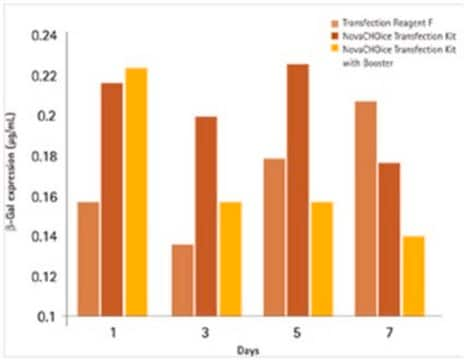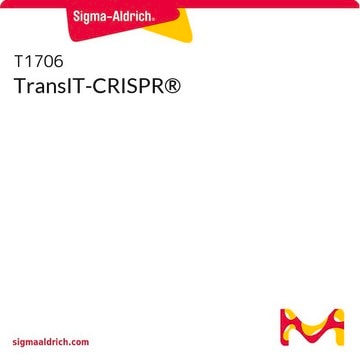NPT01
NeuroPorter™ Transfection Kit
Lipid formulation for nucleic acid transfections in neuronal and glial cells
Sinonimo/i:
NeuroPorter Transfection, Transfection Kit
About This Item
Prodotti consigliati
Grado
for molecular biology
Livello qualitativo
Forma fisica
dried film
impiego
kit sufficient for 75-200 transfections
Disponibilità
available only in USA, Canada and EU
tecniche
transfection: suitable
Temperatura di conservazione
2-8°C
Categorie correlate
Descrizione generale
Applicazioni
- C6 glioma (human)
- Cortical neurons (rat primary)
- Dorsal Root Ganglion (DRG) cells (rat)
- NT2 neurons(human precursor cells)
- NT neurons (human differentiated cells)
- Subventricular Zone (SVZ) cells (mouse)
- White matter cells (mouse)
Caratteristiche e vantaggi
- Optimized for primary neurons, glial cells, and cultured neural cell lines
- Very low toxicity with no neuro-degeneration or dendrite withdrawal
- Efficient DNA delivery primary neurons, glial cells, and cultured neural cell lines
- Fast and easy to use compared to other methods
- Compatible with both serum and serum-free transfection protocols
Componenti
1.5 mL Hydration Buffer H9036
7.5 mL DNA Diluent D1941
Avvertenza
Principio
Note legali
Prodotti correlati
Codice della classe di stoccaggio
12 - Non Combustible Liquids
Punto d’infiammabilità (°F)
Not applicable
Punto d’infiammabilità (°C)
Not applicable
Certificati d'analisi (COA)
Cerca il Certificati d'analisi (COA) digitando il numero di lotto/batch corrispondente. I numeri di lotto o di batch sono stampati sull'etichetta dei prodotti dopo la parola ‘Lotto’ o ‘Batch’.
Possiedi già questo prodotto?
I documenti relativi ai prodotti acquistati recentemente sono disponibili nell’Archivio dei documenti.
I clienti hanno visto anche
Articoli
Transfection introduces genetic material into cells, aiding research in gene expression and cell biology.
This brief webinar provides an overview of what transfection is and the methods that are used to introduce DNA or RNA into eukaryotic cells.
Contenuto correlato
Browse our convenient transfection reagent selection guide to match the best reagent for your specific cell line and application needs.
Il team dei nostri ricercatori vanta grande esperienza in tutte le aree della ricerca quali Life Science, scienza dei materiali, sintesi chimica, cromatografia, discipline analitiche, ecc..
Contatta l'Assistenza Tecnica.















